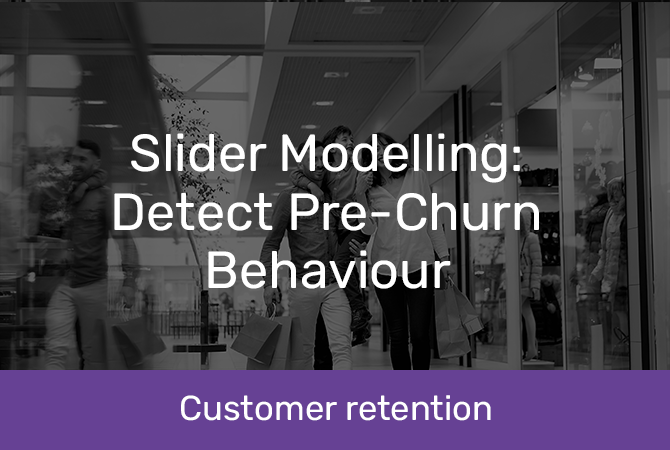Slider Modelling: Detect Pre-Churn Behaviour
Take action early in your customer retention strategy
Customer loyalty is the lifeblood of businesses, driving sustainable growth, profitability, and resilience in an increasingly competitive marketplace.
It is well-known that customer retention costs significantly less (that is, anywhere from five to 25 times less) than customer acquisition. This means marketing teams balance their time working on acquisition and retention campaigns. Deep customer behaviour insight can replace guesswork and make marketing easier.
With customer expectations constantly evolving, losing valuable customers to churn can deal a significant blow to your bottom line. To stay ahead of the curve, you need to get straight to the source – addressing pre-churn behaviours in your customers.
 Sliders and churn customers
Sliders and churn customers
Churn behaviours do not exist in a “they’re doing it or they’re not” framework. At Datamine, we think of it as a scale ranging from sliders and soft churn to hard churn.
What does a churning customer look like? For the sake of simplicity, we will use the example of customers at a bakery chain. In this case, a high-value customer might visit the bakery daily. But suddenly, the customer doesn’t show up, or the frequency of visits starts to slow down. What drives these behaviours, and can they be mitigated or changed using marketing?
Sliding
Sliding denotes the slow erosion of customers over time. While they are very similar, sliders are not technically churning customers; instead, they are demonstrating pre-churn behaviours.
If the bakery’s high-value customer starts only visiting once a week, this is an example of sliding. The behaviour is still regular but less frequent than it used to be. Any change in circumstances could have caused the slide – moving house, changing jobs, getting up earlier to make breakfast, going to the gym, or having a baby.
The bakery hasn’t lost the customer, but this is the first step towards losing this customer to a competitor.
Soft churn
A soft churn customer is someone whose purchase frequency lessens over time in an irregular way. For example, high-value bakery customers stop coming daily and only visit the bakery sporadically.
Hard churn
Hard churn denotes a customer cutting ties with a business altogether. There are two ways somebody could hard churn:
- Involuntary: an involuntary churn can take place when somebody shifts house to a new town and is no longer a customer. If we think about our bakery example, the same bakery would no longer be a convenient place to stop for breakfast for that customer.
- Voluntary: If your customer stops shopping with you and chooses a competitor, that is voluntary churn. For example, a new bakery might open up and your customer makes the switch.
Hard-churn customers are tough, and sometimes impossible, to get back.
 Slider modelling: Stop churn before it starts
Slider modelling: Stop churn before it starts
Slider modelling uses statistics to detect pre-churn behaviours at a time when you can act to change customer behaviour.
Your existing customer data usually provides enough information to set up a slider model. These models give you a view of your customers’ behaviour over time, enabling you to identify patterns and detect when your high-value customers leave as early as possible. Once you have determined what data points you can use to predict sliding, you can look at individual customers to decide whether or not they look like they may slide.
The best way to stop churn is to do it before it happens, and that is fundamental to slider modelling. Using these models, you can identify recognisable and actionable critical points during a customer’s journey, from early warning signs to last-chance cut-offs.
At each stage, you can send out appropriate communications, whether through targeted marketing campaigns, offers or discounts, to capture the attention of those customers and encourage them to keep coming back.
Key advantages of slider modelling
- Know when a customer is going to slide early
- Create more value for your sliding customers
- Save money on customer acquisition by investing in retention
Key considerations
As with any data-driven strategy, you need to have a clear understanding of the problem you are trying to solve before you can design your solution. If you’re considering slider modelling, make sure you can answer the following questions:
What customers are you looking to stop from sliding?
Most Datamine clients start slider modelling projects with their high-value customers. Typically, approximately 80% of spend comes from around 20% of your customers. Keeping your most important customers coming back for more starts by having a robust means of measuring your target population.
What is your current definition of sliders or churn (if you have one)?
It’s important to ensure alignment across your teams as to how you define sliders and churn customers.
What conditions need to be met before you consider a customer to be sliding?
For example, X number of visits and $Y spent over a certain period.
How accurate do you need your model to be?
For example, a false positive or a false alarm could be costly for one business, while others would prefer to capture as many potential sliders as possible. A good example is shifting – for instance, utility companies often want to capture as many sliders as possible because when people move house, they typically churn.
 Get started
Get started
Identifying pre-churn behaviours and addressing them early is crucial to retaining customers and driving sustainable growth for your business.
Create value for your sliding customers, save money on customer acquisition, and ensure customer loyalty and satisfaction by equipping yourself with a slider modelling solution. With the right approach, you can stay ahead of the curve and keep your customers coming back for more.
What’s next? Take a look at the Further Reading list below or get in touch to discuss your customer retention concerns and whether a slider model is right for your business.
Further reading
Read these articles to deepen your understanding of churn and how predictive models apply to churn. The third article, 4 Components of a Great Customer Retention Strategy, breaks down several ways you could address your customer retention concerns along with churn modelling.
The Datamine Guide to Customer Retention
If you have a strong grasp of slider and churn modelling, the Datamine Guide to Customer Retention can help you progress to a great customer retention strategy.



















































